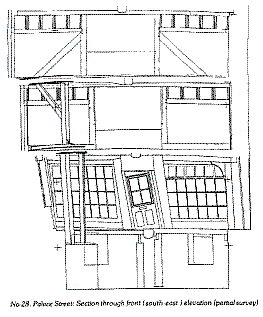 |
No. 28 Palace Street
|
|
|
This survey of the old King's School shop, was the last and probably most demanding undertaken by John Bowen before his departure in May of this year (1988). Archaeological surveys normally address themselves to the evolutionary development of a structure; however, in this case detailed drawings showing the structural failure were required. The King's School shop is believed by some to have been built by Sir John Boys (d. 1612), however, an apparent `construction' date of 1617 can be seen at the apex of the gable and this probably suggests that the association with Sir John Boys is erroneous.
The timber frame has survived relatively intact, with only minor alterations made to the frame in subsequent centuries. The most visible changes in building form occur at ground floor level facing Palace Street, where inserted eighteenth century fenestration and framing (the bracket mortices for the original projecting windows survive together with details for higher frieze fenestration) was replaced by the existing shop door and windows. This work, which was possibly executed in the early nineteenth century, may have been part of a larger rebuilding campaign which also encompassed the replacement of other elements of original fenestration, the provision of new fireplaces throughout, the partial underpinning in brick of the west end against King Street, together with drastic modifications to the stack. These modifications, principally the insertion of an additional fireplace and passageway into the stack at ground floor level, appear to be the root cause of structural failure. The weight of the stack is to a large degree being supported by the original box framing of the building. The stack leans to the north and has also twisted. Movement can be seen in the stack from basement level upwards with stress fractures and perished brick work being only too apparent, on all floors. Attempted repairs in more recent times have not totally arrested movement, since they have addressed the symptoms and not the cause of structural failure. As a result, these repairs may have exacerbated the problems, in that they appear to be lifting the floors off the supporting frames and thereby shifting the original loads and inherent balance of the box frame fabric. It is only the quality of original carpentry and framing that has kept the building standing; a tribute to the craftsmen who originally designed and constructed the building. Any repairs or remedial works that are hopefully to be undertaken in the near future should seek remedies that are not only visually, but more importantly structurally, compatible with the original design Although the de-stabilised stack is undoubtedly the principal problem to be addressed, many other structural failures caused by the depression, compression and general shift of the stack are suspected. These, together with general maintenance problems i.e. damp, perished brick work and rotted timbers, will undoubtedly make up an extensive list of refurbishment work to be undertaken at the same time. This survey was funded by the Kings School.
|
Peter Collinson Last change: 18th November 2018
 No. 28 Palace Street is a three and a half storey, timber-framed
building with double jetties against Palace Street and King Street.
The timber framing is built above a brick cellar and a substantial
contemporary brick chimney stack is centrally located in the
building. The original access to the domestic parts of the structure
was via a lobby entry from King Street which led directly to a stair
(built against the chimney stack) giving access to the upper floors.
Separate access to the shop area, opening onto Palace Street,
is also likely. Openings to front and back ground-floor rooms
(separated by the stack) are situated at opposite ends of the lobby.
Access to the cellar is also gained from the lobby.
No. 28 Palace Street is a three and a half storey, timber-framed
building with double jetties against Palace Street and King Street.
The timber framing is built above a brick cellar and a substantial
contemporary brick chimney stack is centrally located in the
building. The original access to the domestic parts of the structure
was via a lobby entry from King Street which led directly to a stair
(built against the chimney stack) giving access to the upper floors.
Separate access to the shop area, opening onto Palace Street,
is also likely. Openings to front and back ground-floor rooms
(separated by the stack) are situated at opposite ends of the lobby.
Access to the cellar is also gained from the lobby.